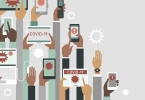Reading: Chủ đề Covid 19 (Phần 1)
Cùng Diễn Đàn Tiếng Anh luyện tập kỹ năng đọc tiếng Anh thông qua bài đọc về Covid 19 dưới đây nhé!
Đọc các đoạn văn dưới đây và trả lời 10 câu hỏi trắc nghiệm:
Read the passage given below and answer 10 multiple choices:
-
The novel coronavirus has given rise to a global pandemic that has destabilized most institutional settings. While we live in times when humankind possesses the most advanced science and technology, a virus invisible to the naked eye has massively disrupted our lives, economies, healthcare, and education systems worldwide.
-
Given the corona virus’s current situation, some households have also had time to introspect on gender roles and stereotypes. For instance, women are expected to carry out household chores like cooking, cleaning, and looking after the family. With men sharing household chores responsibilities during the lockdown period, it gives hope that they will realize the burden that women have been bearing and will continue sharing such responsibilities.
-
This tough period also gave people some time to reflect on the importance of keeping themselves fit. With sufficient time in hand, people started investing their time learning new ways to exercise. Those who never exercised before, giving excuses of busy lives, too developed some new habits of Yoga, Pranayam and exercises during the lockdown period. These new habits and people’s increased focus on their health, wellness and immunity will surely change the way we lead our lives even in future.
-
Nature too healed itself during the lockdown period. Restricted human movement led to better air quality, cleaner water bodies and joyful wildlife movements. The human beings, we hope, reflected during this time, how some of their unconscious activities cause disruption in nature and worked out ways to adopt environmental-friendly options for their activities in future.
-
This situation also affected the education sector to a great extent. It has forced us to shift from offline to online mode of teaching-learning process, almost immediately without prior preparation. Is it giving us a peek into the reality ahead? Technology-enabled teaching is definitely the future we are looking towards, but it is important to identify key challenges for students and teachers in the current scenario. Once identified, academic leadership and the government can address these through innovations in the focused areas to minimise the effect of pandemic on the education of the students.
-
The current scenario has also affected our economies to the extent wherein many businessmen had to bear heavy losses in their businesses. The governments and individuals need to take actions to mitigate risk and minimize transmission while maintaining social and economic activities. However, relaxed control measures, declining risk perception and the understandable desire to return to normalcy have led to reduced protective behaviour and more social and workplace interactions, often in confined, close-contact settings, where the virus spreads really fast.
-
It is our responsibility that we take all necessary precautions through mask-wearing, physical distancing and hand hygiene as part of daily life. It is highly important to make these new behaviours part of our everyday habits. Travelling to new places, casual café visits with a large bunch of friends, spending our weekends in shopping, window-shopping and casual strolls, large gatherings in birthday parties and other celebrations; will require some modifications and patience to fit into “New Normal” keeping all the safety norms in mind.
-
We are sure that regular communication from authorities, improved understanding of individual responsibility and, subsequently, a greater willingness to adopt infection prevention practices can be a stepping stone to a “new future”.
1. The outbreak of COVID-19 is called a pandemic because ___.
(a) it has spread across the globe
(b) it has spread across India
(c) it is invisible to naked eye
(d) it has disrupted many institutional settings
2. According to the passage the lockdown period made people introspect on gender roles and stereotypes because ___.
(a) women started handling all the household responsibilities alone
(b) men started handling all the household responsibilities alone
(c) people talked about gender stereotypes during lockdown period
(d) men started sharing responsibilities related to household chores
3. Choose the option that is NOT TRUE:
People, who never exercised before, started exercising during the lockdown period because ___.
(a) they had sufficient time in hand
(b) exercise was the only way to treat people from the novel coronavirus
(c) people learnt new ways to exercise their body
(d) people understood the importance of health and wellness in the face of the pandemic
4. A positive change was seen in nature during lockdown period in terms of cleaner air and water bodies because ____.
(a) there was less human movement due to lockdown
(b) the virus helped in cleaning air and water
(c) the government made extra efforts to clean air and water
(d) people got together to clean water bodies
5. How did schools continue educating students during the pandemic?
(a) Through offline mode of teaching
(b) Through online mode of teaching
(c) By calling students to school on weekly basis
(d) Students were asked to study at home themselves.
6. Which of the following has NOT led to reduced protective behaviours amongst people?
(a) Relaxed control measures
(b) Declining risk perception
(c) Physical distancing
(d) Understandable desire to return to normalcy
7. Which of the following is OPPOSITE in meaning to the word ‘mitigate’ as used in the passage?
(a) lessen
(b) reduce
(c) aggravate
(d) weaken
8. Which of the following is NOT TRUE in the context of COVID Appropriate Behaviour?
(a) Wearing Mask
(b) Being in crowded places
(c) Washing hands
(d) Maintaining physical distancing
9. The phrase “stepping stone” refers to:
(a) Stones and pebbles lying on the road
(b) Something used as a way to progress
(c) The destination of our journey
(d) Blocks and problems in your path
10. Which of the following statements is NOT TRUE in the context of the passage?
(a) People started introspecting on gender roles and stereotypes.
(b) People started realising the importance of keeping themselves fit.
(c) There was a boom in the economy.
(d) School started following Technology-enabled online teaching.
Đây là phần bài tập đọc tiếng Anh có đáp án nên sau khi đã xem kỹ lại bài làm thì hãy kiểm tra đáp án và lời giải chi tiết ở dưới đây nhé! Chúc các bạn may mắn.
Answer key:
1.a (Đoạn 1 dòng 1)
2.d (Đoạn 2 dòng 3-5)
3.b (Đoạn 3 dòng 2 ứng với câu a; dòng 2-3 ứng với câu c và dòng 5-6 ứng với câu d)
4.a (Đoạn 4 dòng 1-2)
5.b (Đoạn 5 dòng 1-2)
6.c (Đoạn 6 dòng 3-6)
7.c (mitigate: làm giảm nhẹ, dịu bớt, làm cho đỡ ; aggravate: làm trầm trọng, nặng thêm)
8.b (Đoạn 7 dòng 1-2)
9.b (a greater willingness to adopt infection prevention practices can be a stepping stone to a “new future được hiểu như: sự đồng lòng hơn trong việc áp dụng các biện pháp phòng chống lây nhiễm có thể là bước đệm cho một “tương lai mới”)
10.c (Câu a ứng với nội dung của đoạn 1, câu b ứng với nội dung của đoạn 3, câu d ứng với nội dung của đoạn 5)






-145x100.jpg)




Bình luận